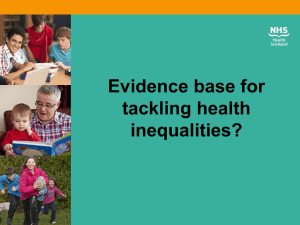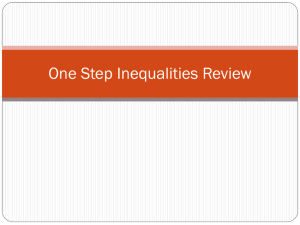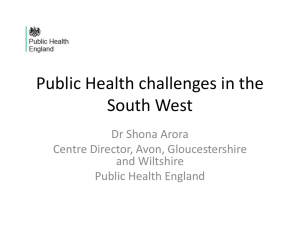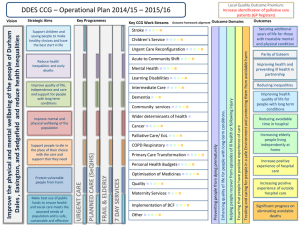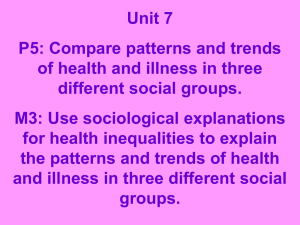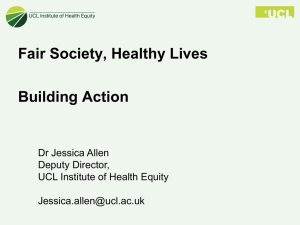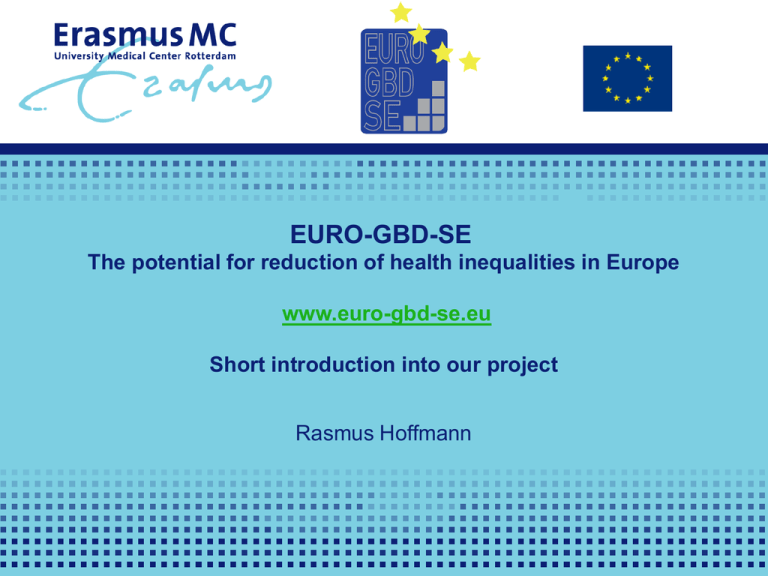
EURO-GBD-SE
The potential for reduction of health inequalities in Europe
www.euro-gbd-se.eu
Short introduction into our project
Rasmus Hoffmann
Main objectives
The EURO-GBD-SE project aims at assessing the potential for reduction of health
inequalities in Europe, by first identifying the determinants and risk factors associated
with variations in the magnitude of health inequalities between European countries.
The second step is to use these measures to develop counterfactual scenarios by
using epidemiological calculation methods (Population Attributable Fraction).
The project estimates the extent to which health inequalities in Europe can (theoretically
and realistically) be reduced by policies and interventions on socioeconomic
determinants as well as on specific risk factors.
Updated estimates of the magnitude of socioeconomic inequalities in health in Europe.
Scenarios
2 main scenarios
Changing the distribution of education
Changing the exposure to a risk factor (by socioeconomic group)
Together, the risk factor scenarios and the more radical educational redistribution
scenarios provide a good first picture of the theoretical potential for reduction of
educational health inequalities.
Europe offers excellent opportunities for such analyses
Data on inequalities in mortality, morbidity and risk factors are available in many countries.
European welfare systems differ substantially
Variations of health inequalities are already found.
Data preparation
The project has collected four kinds of data:
1.
Educational distributions
2.
Prevalences of risk factors (RF)
by country, sex, age and education. The primary source is Health Survey data.
3.
Rate Ratios (RRs)
for the impact of RFs on health outcomes.
assumingly reflecting the causal relationship between the RFs and health.
4.
Mortality rates
by country, sex, age, education, for all-cause mortality and by causes of death
From the mortality rates we calculated RRs between educational groups by country,
sex, age, for all-cause and cause-specific mortality.
Risk factors
- Smoking
We calculate PAF’s for
- BMI
- Physical activity
- 21 European populations
- Diabetes
- men and women
- Fruit/vegetables
- 4 age groups (30-79)
- Social participation
- 3 educational groups
- Occupational status
- for all-cause mortality and 22 causes of death.
- Activity status
- Income
(alcohol has been skipped).
Details about the methods can be found in Hoffmann et al. 2012 (JECH)
Fi
nl
a
Sw nd
ed
No en
rw
En De ay
gl nm
an a
d/ rk
W
a
Sc les
Ne otla
th nd
er
la
Br nds
us
se
Fr ls
Sw an
itz ce
er
la
n
Au d
Ba str
rc ia
el
o
Ba na
sq
u
M e
ad
rid
Tu
Tu rin
sc
an
Po y
la
Hu nd
ng
Li ary
th
ua
n
Es ia
to
n
Eu ia
ro
pe
(in %)
Percentage reduction of mortality in maximum educational scenario
Kulhanova I, Hoffmann R et al (in preparation)
100
90
Men
Women
80
70
60
50
40
30
20
10
0
Number and percentage of saved deaths from all cause mortality among men
per 100.000 among low and mid educated
Upward leveling scenario where the exposure to each risk factor is as among the high educated
Mortality RRs, scenario RRs and potential reduction of inequality in
mortality (in%) between high and low educated persons in different
Mortality RRs, scenario
RRs and potential
reduction
in inequality R
in mortality
%) between those with high and low education due to different smoking
smoking
scenarios
(Kulik
M, Hoffmann
et al, in(inpreparation)
scenarios
All-cause mortality
Upward leveling scenario
Best-practice scenario
initial RR
initial RR
new RR
Ineq. Redu.
new RR
Ineq. Redu.
new RR
Ineq. Redu.
new RR
Ineq. Redu.
M
W
M
M
W
W
M
M
W
W
Finland
1.95
1.77
1.79
17
1.71
8
1.88
7
1.72
7
Sweden
1.76
1.82
1.62
19
1.74
10
1.7
8
1.64
22
Denmark
1.82
1.74
1.67
18
1.68
8
1.73
11
1.55
25
England/W
1.69
1.62
1.51
26
1.52
16
1.58
15
1.42
32
Scotland
2.03
1.95
1.8
22
1.76
20
1.88
15
1.65
32
Netherlands
1.79
1.54
1.69
13
1.51
7
1.72
9
1.4
25
Brussels
1.85
1.61
1.79
7
1.6
2
1.84
2
1.52
15
France
2.2
1.61
2.14
6
1.59
2
2.2
0
1.59
3
Switzerland
2.02
1.52
1.93
10
1.51
2
1.98
5
1.45
13
Austria
1.86
1.51
1.77
11
1.5
2
1.87
0#
1.5
2
Barcelona
1.54
1.35
1.5
8
1.34
2
1.56
0#
1.36
0#
Basque
1.4
1.2
1.36
9
1.2
4
1.4
0#
1.2
4
Madrid
1.42
1.27
1.39
8
1.27
2
1.44
0#
1.29
0#
Turin
1.56
1.14
1.54
5
1.14
2
1.57
0#
1.14
0
Tuscany
1.64
1.28
1.61
4
1.28
1
1.65
0#
1.28
0
Hungary
2.99
1.69
2.97
1
1.69
0
3.11
0#
1.64
6
Czech Rep.
2.86
2.19
2.52
19
2.14
5
2.68
10
2.11
7
Lithuania
2.34
2.14
2.15
14
2.11
3
2.22
9
2.14
0
Estonia
2.48
2.31
2.27
14
2.24
6
2.42
4
2.24
6
Population
General results and conclusions
First, the EURO-GBD-SE project has shown that inequalities in mortality and morbidity in
Europe have persisted into the 21st century, and manifest themselves in patterns that are
broadly similar to those seen in the 1990s. This implies that they continue to be one of
the main challenges for public health policy.
Second, EURO-GBD-SE has shown that the explanation of inequalities in mortality,
in terms of the quantitative contribution of specific risk factors, differs between European
countries. This implies that different countries have different entry-points for policies
against health inequalities.
Third, EURO-GBD-SE has shown that many countries can reduce relative inequalities in
mortality by up to 10, 20 or even 30% if they would succeed in reducing inequalities in
one or more risk factors to the level currently seen in the European country with the
smallest inequalities in exposure.
Thank you!

